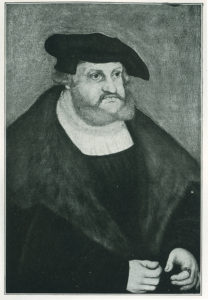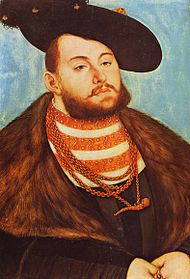by Dr. Jack Kilcrease
Martin Luther, along with John Calvin, Ulrich Zwingli, Martin Bucer, and Thomas Cranmer are often referred to as the “Magisterial Reformers.” By “magisterial” early modern historians typically mean that they reformed their respective regional churches with the help of local magistrates. Such a program stands in contrast with those figures often called the “Radical Reformers” who sought to reform the Church without the help of secular authorities. Indeed, in many cases the radical reformers (notably, Thomas Müntzer) revolted against their governments with open violence. Below we will focus on political rulers who play a critical role in the genesis and success of the Lutheran Reformation.
The first significant political supporter of Luther’s Reformation was Fredrick the Wise. Fredrick was the elector of Saxony at the time that Luther began to protest the sale of indulgences (1517). Fredrick’s office as an “Elector” meant that within the imperial system of the Holy Roman Empire he had the right to vote on who would succeed the present emperor. It should be understood that the Holy Roman Empire was made up of numerous semi-autonomous principalities. Nevertheless, only seven designated rulers, known as electors, were allowed to vote on who became the emperor. For this reason, Fredrick had a much greater pull with the imperial government than other German magistrates. As a result, Fredrick was able to defend Luther in a way that other German princes would not have been able to.
Fredrick and his policies helped contribute to Luther’s success in a number of ways. First, Fredrick established the University of Wittenberg in 1502, where Luther taught and eventually launched his reform. Secondly, by using his political clout as an elector Fredrick protected Luther from both the pope and the emperor. Since Fredrick was an elector and the emperor Maximillian I died a little over a year after Luther began his protest against indulgences (January, 1519), the pope showed an excessive deference to the elector in order to influence his vote. Hence Fredrick was able to delay any direct condemnation of Luther and ultimately made certain that the Reformer would receive a public hearing at the Diet of Worms (1521). Lastly, Fredrick helped Luther hide in the Wartburg Castle after he had been declared an outlaw by the Edict of Worms (1521).
Fredrick the Wise died in 1525 and was succeeded by his brother John. John did not last long on the throne and was succeeded by his sons John Fredrick and John Ernest in 1532. In 1542, John Ernest died and his brother John Fredrick became the sole ruler. John Fredrick was been educated by George Spalatin, Fredrick the Wise’s court preacher and a close friend of Luther. As a young man, John Fredrick was devoted to Luther’s teachings and cultivated a strong relationship with the Reformer.
John Fredrick did much to help Luther. First, he strengthened Saxony’s support for the Smalkaldic League. The Smalkaldic League was an organization formed by a number of Lutheran princes as a means of collective security against the encroachments of the Roman Catholic Emperor Charles V. John Fredrick also increased his support for visitations to local churches throughout Saxony. In this, he sought to assess the theological and moral health of individual parishes, as well as develop necessary measures for their internal reform. In order to more strongly promote and more appropriately manage these reforms, John Fredrick also centralized control of the Saxon church under a single system of ecclesiastical governance.
When the Smalkaldic War broke out (1546-1547), John Fredrick went to battle at the head of his troops. He was initially successful against his cousin Maurice who had sided with the emperor Charles V in a ploy to steal John Fredrick’s lands. Nevertheless, John Fredrick was finally overpowered by the Charles’ imperial troops and defeated at the Battle of Mühlberg in 1547. Not only was John Fredrick defeated, he was captured, imprisoned, and sentenced to death. This sentence was eventually commuted to life in prison, but John Fredrick still refused to accept the religious compromise proposed by the emperor (the Augsburg Interim) and held steadfastly to the teachings of the Augsburg Confession. This earned him the name “John Fredrick the Steadfast.” In 1552, John Fredrick was released from prison after his cousin Maurice turned on the emperor. John Fredrick died two years later at the age of fifty.
Although neither Fredrick the Wise or John Fredrick the Steadfast were professional theologians, they were men of faith who helped reformers like Luther perform their vocations. This reminds us of the important role that ordinary believers have within the Church in supporting the work of theologians and pastors as they continue their divinely appointed tasks of teaching and evangelization.
Jack Kilcrease is a member of Our Savior Lutheran Church, Grand Rapids, Mich.

